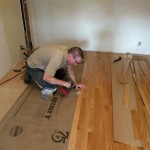How to Replace Flooring: A Step-by-Step Guide
Replacing flooring can transform the look and feel of your home, but it can also be a daunting task. With careful planning and a little elbow grease, you can achieve professional results while saving money. Here's a comprehensive guide to help you navigate every step of the flooring replacement process.
Step 1: Choosing the Right Flooring
The first step is to select the type of flooring that best suits your needs and preferences. Consider factors such as durability, moisture resistance, comfort, and style. Popular options include hardwood, laminate, vinyl, tile, and carpet. Each option has its unique advantages and drawbacks, so research thoroughly before making your decision.
Step 2: Preparing the Subfloor
Before installing new flooring, it's crucial to prepare the subfloor. Remove the existing flooring, baseboards, and any nails or staples. Inspect the subfloor for damage, unevenness, or moisture issues. If necessary, repair or replace damaged areas. Ensure the subfloor is level and smooth to create a stable base for the new flooring.
Step 3: Installing the Flooring
The installation method varies depending on the type of flooring chosen. Follow the manufacturer's instructions carefully to ensure proper installation. For example, hardwood flooring may require nailing or stapling, while laminate flooring typically uses a click-lock system. Take your time and use the appropriate tools to achieve a clean and precise finish.
Step 4: Installing Baseboards and Trim
Once the flooring is in place, it's time to install the baseboards and trim. Baseboards cover the expansion gap between the flooring and the wall, preventing moisture damage and adding a finished look. Trim pieces can be used around windows, doors, and other architectural features to complete the aesthetic.
Step 5: Finishing Touches
To complete the flooring project, add any necessary finishing touches. This may include applying a sealant to protect the flooring from wear and tear, installing transition strips between different flooring types, or placing rugs and furniture to enhance the overall design.
Tips for Success
* Plan the layout carefully to minimize waste and optimize the use of materials. * Use a level to ensure the subfloor and flooring are even. * Allow for expansion gaps to prevent buckling or warping due to temperature and humidity fluctuations. * Take your time and don't rush the process to avoid mistakes. * If you're not confident in your DIY skills, consider hiring a professional flooring contractor.
How To Replace Flooring 8 Excellent Ideas Floorings

Replace Damaged Board Floor Sheathing Fine Homebuilding

How To Repair And Replace Wood Flooring Pro Tool Reviews

How To Repair And Replace Wood Flooring Pro Tool Reviews

How To Repair Hardwood Floors The Craftsman Blog

How To Replace Flooring 8 Excellent Ideas Floorings

How To Replace A Damaged Hardwood Floor Board Diy Family Handyman

Flooring Repairs 101 When To Repair Vs Replace

How To Easily Replace A Damaged Laminate Floor Plank Interior Design Wonderhowto

How To Repair Laminate Flooring The Home Depot
Related Posts








